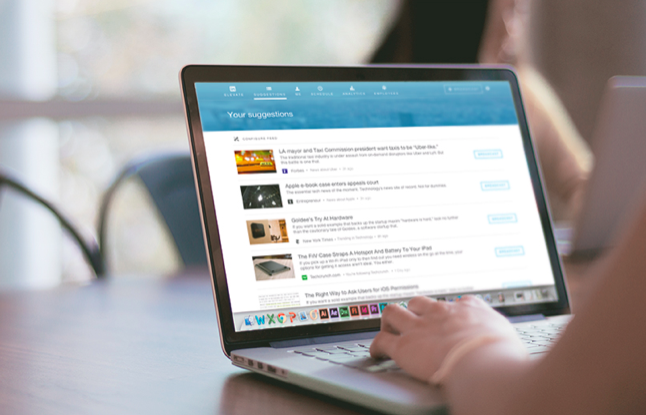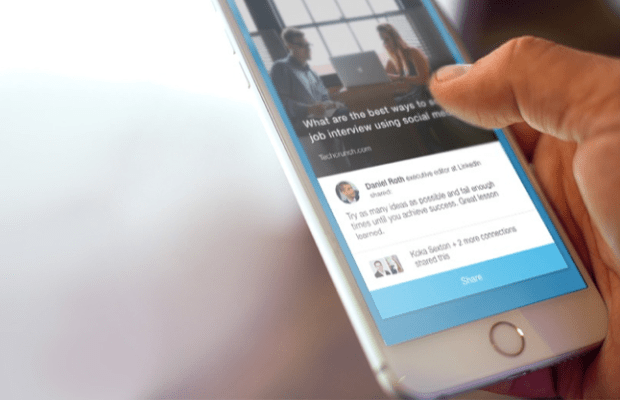LinkedIn, the social platform with 350 million users where people network for business deals, new jobs, news, and soon to learn a thing or two, is now tapping another business area: social media management.
Today, the company is taking the wraps off Elevate, a paid mobile and desktop app that suggests articles to its users — based on algorithms from its news recommendation services Pulse and Newsle, as well as “human curation” — and then lets users schedule and share those links across LinkedIn and Twitter, with the aim to add more networks like Facebook over time.
Elevate is opening up for a closed, paid pilot starting today. Like Facebook at Work, anyone will be able to download the iOS or Android apps. But only those who are signed up for Elevate (and paying for it) will be able to use it.
The plan is to have Elevate in general availability by Q3 of this year, at which point LinkedIn will also unveil pricing. In Q1, LinkedIn says it ran a private pilot with several large companies, including Unilever, Adobe and Quintiles, which is helping it figure out how the app is getting used, and what form that pricing might take.
So what Exactly is Elevate?
You can think of Elevate as a very pared-down, LinkedIn-focused Hootsuite, which lets users schedule and share social media content across multiple networks. Or, perhaps more directly, LinkedIn’s version of the Daily app from Buffer, which uses the Buffer’s content suggestion technology and then lets you schedule and share those links. Or you can think of it as LinkedIn’s latest move to compete against the likes of Salesforce — perhaps some combination of all three.
(The Buffer similarity is interesting, incidentally, given that one source close to LinkedIn told me a while back that he had suggested to higher-ups at the company that it should try to buy the startup.)
Just as Hootsuite and Buffer are designed for both social media professionals and more casual social media junkies, the idea behind Elevate is the same.
For marketing professionals, it helps them keep the social media wheels turning, with story suggestions letting them stay active even when they have no links of their own to share, and analytics to track how well things are performing. They will be able to create specific topic areas to track, for example related to specific company objectives (e.g, a campaign aimed at hiring more female engineers).
But what’s interesting is that Elevate seems to be aimed also at having a wider appeal to a company’s larger pool of employees, effectively co-opting them in the larger social media marketing effort. For them, one carrot is that they can use Elevate to track how sharing content leads to more profile views and other stats — or, as product manager Will Sun puts it, Elevate helps general “employees to be social professionals.”
Rousing up more employees in a company network is actually a largely untapped area for LinkedIn. It says that today only about 2% of a company’s employees share their company’s news on LinkedIn, but collectively those employees will have ten times as many connections on LinkedIn as their company-employer does.
To sweeten the deal for those considering Elevate, LinkedIn has shared some of the early results of how Elevate’s closed pilot performed. Unsurprisingly, the numbers are positive. LinkedIn says that for each six pieces of content that are shared by an individual, on average, that individual receives six profile views and makes two new connections.
And LinkedIn says that when an employee shares content, on average its employer results in six job views, three Company Page views, and one Company Page follower, “which helps them better hire, market, and sell,” writes Sun.

Of course, Elevate holds a lot of potential benefits for LinkedIn, too.
As the company continues to look for more revenue growth, LinkedIn has been diving into a lot of new areas in the last couple of years, specifically to build out its content business.
That has included acquiring news recommendation services Newsle and Pulse; growing its publishing platform — which now sees 50,000 pieces of content each week — and also adding whole new business areas, like e-learning site Lynda.com, acquired last week for $1.5 billion.
Although Elevate sits in LinkedIn’s business solutions division, it’s also a content play of another kind: it provides more data points and potential traffic for LinkedIn content, which in turn will help boost traffic and engagement on the network.
But there is still a long way for LinkedIn to go when it comes to engagement on its site — recall the 2% stat that it shared for employees sharing company news. Elevate could go some way to improving that ratio.
On the other hand, building a paid B2B social media management service also gives LinkedIn another potential revenue stream to grow its business solutions, providing a stronger complement to revenues that LinkedIn makes from recruitment services (“Talent Solutions“) and its growing advertising business (“Market Solutions”). In total, LinkedIn’s current revenue-generating services collectively brought in $643 million in revenues last quarter.
Indeed, as LinkedIn matures, what may be most important about Elevate is not that LinkedIn may make a killing from this one product, but that it’s raising its B2B apps game.
